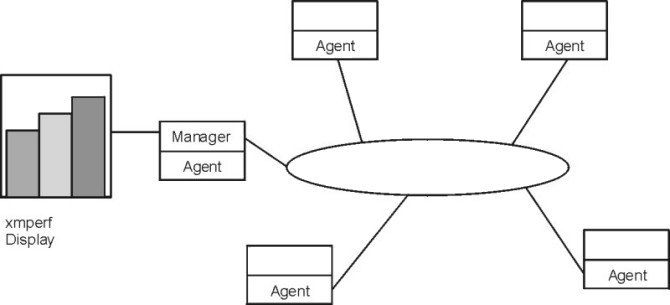
The Performance Toolbox (PTX) is a licensed product that allows graphical display of a variety of performance-related metrics. Among the advantages of PTX over ASCII reporting programs is that it is much easier to check current performance with a glance at the graphics monitor than by looking at a screen full of numbers. PTX also facilitates the combination of information from multiple performance-related commands and allows recording and playback.
PTX contains tools for local and remote system-activity monitoring and tuning. The product consists of two main components: the PTX Manager and the PTX Agent. The PTX Agent is available as a separate licensed product called the Performance Aide for AIX. The following figure shows a simplified LAN configuration in which the PTX Manager is monitoring the activity of several systems.
Figure 5-1. LAN Configuration Using Performance Toolbox. This illustration shows five nodes of a local area network that are connected using the star topology. Each node on the network has the performance toolbox (PTX) agent running on it. One of the nodes is the PTX Manager and can monitor the other nodes via the resident agent.
 |
The main purpose of the PTX Manager is to collect and display data from the various systems in the configuration. The primary program for this purpose is xmperf. The primary program used by the Agent to collect and transmit data to the Manager is xmservd.
PTX is described in detail in the Performance Toolbox Version 2 and 3 for AIX: Guide and Reference and Customizing Performance Toolbox and Performance Toolbox Extensions for AIX.
If you need to record information or a playback facility, several tools are included with the manager code (xmperf, 3dmon, azizo, ptxrlog). Other tools (xmservd, ptxtab, ptxsplit) are packaged with the agent code.
Best suited for continuous monitoring are the following tools: